This 12 x 10 cm notebook is bound in red leather with the border embossed: the brass clasp is intact. The back of the notebook has a 3 x 7 cm cream-coloured paper label with 'Copiapò. Despoblado Isle of France Cape of Good Hope. excursion St Helena.' written in ink. There are 128 yellow-edged pages.
[front cover]
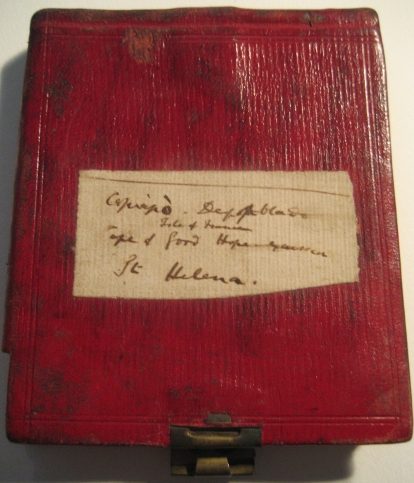
Copiapò. Despoblado
Isle of France
Cape of Good Hope. excursion
St Helena.
[inside front cover]
[illeg] y 26-27
Luccocks Notes of R de Janeiro & (M. Video) 4to 18201
1 Luccock 1820.
[page 1a]
Limit of Basin
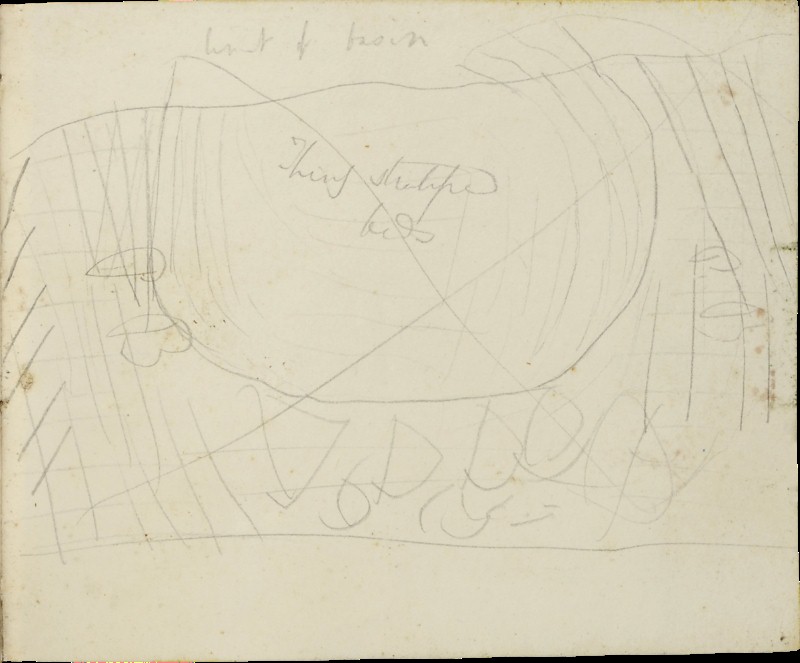
Thinly stratified beds
P.B. P.B.1
1 This diagram was eventually published in South America, p. 231.
[page 2a]
[slaving?] vessel
revolution
Price of water 18 — P.B. 1 B — ½ m. —
no wood. —
Sand — detritus. absolute desert
S. Rosa — Guantajaya state more curious
Tufaceous — deposit like lake —
[pages 3a-4a excised]
[page 5a]
Mem copy notes in Humboldt Vol V P I1 —
V. Beechey [N.B.]
The Barking <bird>2
1 Humboldt 1819-29, vol. 6.
2 See specimen 2532 in Zoology notes, p. 279.
[page 6a]
Bits of dead coral
Volcanic pebbles.
Flagstaff & La Puce
15º 50'
[page 7a]
P. B & La Puce 13.1
[pages 8a-10a largely excised]
[page 11a]
( 57 (3) )
bright pink granular centre envelope distinct
rather smaller than orifice their orfice of cell
8 or 12 perhaps in a circle in flocculent matter1
1 Notes on dissecting coralline algae under the microscope, specimen 3686 collected at the Cape of Good Hope in June 1836, Zoology notes, p. 51 and Beagle plants, pp. 199-200.
[page 12a]
Holdfast Tom & Prosperous Bay. between these a great level basin, with track near coast of ossiferous soil, sea birds, not now inhabitants of beach.
Dianas peak is part of the Basaltic chain.
[page 13a]
Flagstaff & the Barn parts of the Crater.
Lott worth visiting [point] of basalt though stratified rocks
[page 14a]
Dianas peak
Sandy Bay
Lotts Pillar & Wife }
Flagstaff Hill & barn }
Bencoolen Plain }
Prosperous Bay }
؟ Iron at Longwood (near Napoleon)? 7 miles from
Gregories Valley
Turk Caps Bay
[pages 15a-22a excised]
[page 23a]
Off Pernambuco.
17 Fathoms essentially red corallina small pieces in continental dead & living; few minute fragments of shells & opercula
40 fathoms [20] fathoms very fine grained minute yellowish brown particles of shells?
10 9 Fathoms Corallina & shells rounded articles of quartz rather coarse for sandstone
[page 24a]
V. Plan for kind of bottom close to anchorage
arrived on 31st [August 1836] —
No kingfishers at present. Sparrow building — land rather greener —
Boabab full of leaves = interesting country — [barren] stony steps
[page 25a]
Centre of Flat hill N 36 W right extreme n 32 W N by E Hill n 13 W SE extreme of table n 1 E mountain with horizontal strata N. From ship
[page 26a]
From cove. West of Quail Isd to extreme SE point 3 & ¼.
5 4 miles & ⅓ ½ from extreme SE point to where I last could see. the white [beach] may be called 8 miles
[pages 27a-42a blank]
[page 43a]
| 2 points of flat hill — |
280 |
| extreme N escarpment. of distant west hill — |
298 |
| Summit of N by E Hill |
305 |
| S.E. edge of table land |
337 327 |
| extends at least to |
334 |
| Right hand flat hill |
285 |
[page 44a]
Extreme point 250 to Flagstaff.
Bluff 48º
Extreme low 62º
NB 4 miles distant

Some other Bearing in Note Book
[page 45a blank]
[back cover]
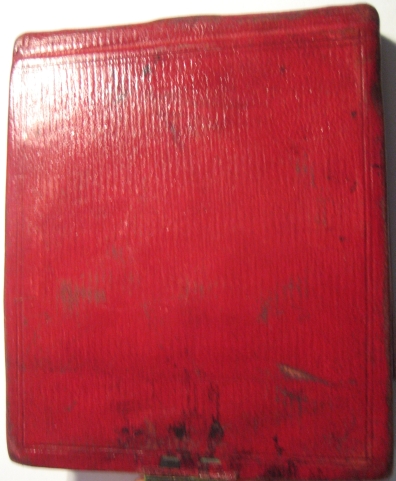
[inside back cover]
[Printed label:]

VELVET PAPER
MEMORANDUM BOOK.
So prepared as effectually to secure the writing from erasure; — with a METALLIC PENCIL, the point of which is not liable to break.
The point of the pencil should be kept smoothly scraped flat and in writing it should be held in the manner of a common Pen.
[Mepal] — Copiapo 405 Nautical miles [Guantajaya] [Pasco] Copiapò [Arqueto]
Mr Caldcleugh veins NNW & SSE
Carb of copper at top.
[page 1b]
(Friday 26th.) [June 1835] Started from Copiapo valley to Despoblado (silver spurs — for burial)
T del Finch 3 sorts of Caracara ||
Vicuna.1 as far as near Guasco
Noticed 3 very distinct plains all on grand scale. the lowest ones the grand one of city.
Hills all about Copiapò. the greenstone — Syenite — also some dark slate Porphyry. Slept at the Agua amarga — putrid. could not drink tea — very severe
1 The Vicuna (Lama vicugna) is the smallest of the llamas and lives at high altitudes in South America. It was much-prized by the Incas for its soft fur.
[page 2b]
frost road very desert bring wood three day journey on donkeys. —
(Saturday 27th) [June 1835] Travelled far up ravine of Paypote, came to water, & trees of Algarroba1 one man watching old smelting furnace road joins Pampas N of Rioca Too much tired to enjoy these situations & perfectly bare hills = During these two days the geology (our course being about NE — E — SE — E &c) has been
1 (=Nimora) a Mimosa plant.
[page 3b]
chiefly a repetition of Valle — Leaving the Syenite we chiefly traversed a mass (I have not attempted a section from extreme complication of stratification) of the upper strata, reddish fine conglomerate yellowish & greenish Sandstone with bands of pebbles, some of the black rock, & the greyish limestone full of pieces of Gryphites & Terebratula — The number of green dykes astonishing, viz. standing out —
[page 4b]

[section]
occasional hills of crystalline rocks one of which was of a curious variety (170) with the sedimentary beds were enormous streams of Lava Lilac & pale &
[page 5b]
very dark Porphyry — also above a white Sandstone the curious Porph in great quantity. = From the quantity of Lava there must have been many volcanoes. surely these isolated cryst hills were such May seem to have little relation as axis with stratification but I think they generally have. — If they are centers of old volcanos, submarine volcano the stream must directly flow out of a hole = these cryst hills frequently stand isolated
[page 6b]
I am surprised the center & stream are not oftener seen, connected — removal & upheaval being on same spot chief cause = Upon some inclined strata, & at corresponding height of 2 diff hills, horizontal mass (like gravel, in height of Potrero Seco) of a very white, very light, Tufa, grains, scales of mica — calcareous — clearly Volcanic —
[page 7b]
interesting as being the 3d instance of Lava after upheaval of strata, yet beneath probably the sea = from Gravel, nature & obscure horizontal lines = I observed some very remarkable forms of stratification 1st is figured at end of book1 & is remarkable by the outer & lower rock being a true Porph — Brecc — which I saw no where else — the inner strata curved more than a yoke ( U ) are of thinly laminated red sandstone & some
1 The sketch is found on p. 1a.
[page 8b]
black rock — there are many horizontal Pushes —
I never saw this double case but several of both single —
NB in the white sandstone a concretionary structure or globule
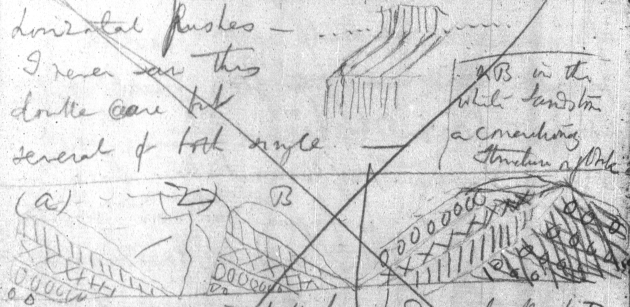
[section]1 (a) (z) B
Two little successive hillocks had a double dyke or upheaval — separated by wedge shaped valley the (X) bed a Lilac Porph by a succession of evident faults, is tilted from about
1 See South America, p. 231.
[page 9b]
45º to vertical & from than till it leans down to an opposite dip of about 45º — which is the head of the little ravine where it rests on continuation of (B) hillock whose strata are also highly inclined, — but I do not know the exact juxtaposition of the strata, when there is an this apparent anticlinal ridge: the x strata being pale & generally denuded shows a curious sinuous band, which may be
[page 10b]
Produced by twisting a slip of paper white sandstone pebbles Porphyries The strata have been twisted 135º. — The great period of Volcanic activity S of Copiapo. (Mem. Mr Lambert notes) was submarine — also I believe nearly all the hills are likewise so, that the outer ridges are subsequent. — that these upper strata removed so as even to see granite generally
[page 11b]
on coast — then P B — Dykes generally subsequent to metallic veins & alteration of sediments — Valleys — Are the Pampas solely owing to being leeward of currents has the weight prevented subsequent upheavals — Chief of these Lavas before tilt — some subsequent, but subaqueous — others terrestrial to this day —
[page 12b]
Sunday 28th [June 1835] We travelled up to the foot of the Linea — that is a line of mountains which sends water to East to great lake of Salt many leagues long = Partridge1 near snow line in Beveys rise like Grouse & make great chattering. Several foxes live on mice — Tracks of Vicuna. This first Cumbre very tame outline nearly on plain = on the road valleys very flat (in one spot very high up below junction ofMaricongo&Azufre2 very distinct plains or fringes above the broard flat base = a large side ravine mouthbarred up owing to their being
1 Probably specimen 2823 in Zoology notes, p. 410 and 'Ornithological notes', p. 260; listed as Attagis gayii in Birds, p. 117.
[page 13b]
no drainage 20 or 30 ft high — water course only just perceptible in soft flat bottom, base sides of soft, immense crumbling mountains not scored by ravines; quite bare — singular aspect of tranquility — All owing to extreme dryness. — Specimen (171) is part of injected mountain; same rock forms immense dykes 10-15 yards wide traversing mountains also a brecciated mass like a Lava, & on upper part of mountain obscure appearance of being like a bed — This hill
[page 14b]
belongs to system of Porphyry hills (170). — (172) a red Porph Lava = The night dreadfully cold, gale of freezing wind — body benumbed — History of Vaqueano — boy 14 years old = gale of wind — May — clear sky — no snow — stones flying — stoop to ride = out of 200 mules 14 only lived — 30 cows died — Brother tried to return on foot, body by a [led] mule skin — clothes — hair — 2 years afterwards other brother lost several fingers & toes. this man could scarcely use his, dreadfully
[page 15b]
swelled. — returned with fresh men to look after Cargo. in return snowed up 3 days with usual clothes No hunger or thirst — yet lost no fingers up to chin = crouched round fire = In evening climbed up to near Cumbre. very much Puna — snow. scanty vegetation — I should think — 8000-10000 feet high = at the very head of the valley on inclined layers of whitish sandstone & limestone Terebratula (with Gryphite — [R Claro] Terebrat) there is a grand Tufaceous formation many 100 ft thick — this can be traced from one mountain to other
[page 16b]
forming mere caps to the first mentioned. — It is horizontal & divided into two masses, the lower reddish (173) much harder included fragments smaller — the upper is 174 quite white, soft crumbling (hence in places are only left groups of pinnacles) contains much mica — grains of quartz, & bits of granite — Mem. Mr Lambert glazed granite, together with bits of Porphyry, but 19/20
[page 17b]
are ∠r fragments, chiefly but not all, small grey Trachytic Lava — In upper parts there was some rounded stones — The plain seems extensive, but I am informed on road to the other side, there is an immediate descent, & continual ascent, & descent till we come to other side, the plain dips to W & small ∠ or rather the little bits of Caps still left — The white Tufa in parts seems highly calcareous like that of yester
[page 18b]
day, before yesterday & brecciated — (is covered by bed several 200 ft thick of some darker substance, not Lava) horizontally junction very regular, cannot doubt aqueous deposit = product of sea subsequent to upheaval & amongst outlying islands — Having crossed first line proceeding to north about 15 leagues, over dead level plain (with very much Puna), this plain covered with shingle — This & the
[page 19b]
aqueous Tufa (although ∠r fragments) NB did not find the source of Trachytic Lava but probably the red rounded hills which rose in places, the whole top of the Cordilleras are here a recent aqueous deposit, being horizontal, proof of horizontal upheaval to that amount In this plain at foot of a mountain is a grand Lake; many leagues long, not very deep, but much mud — Salt deposited Snow water, dried in summer, deposited in layers very hard — mules enter by a Peninsula
[page 20b]
Monday 29th) [June 1835] Returned to same sleeping place — (I believe the Carrancha & Chimango are found here) — Certainly the former. — The Plain of Salina is surrounded by mountains, but very broad, & nearly two days journey long — may be Lake — (Mem Lake South Pampas of Mendoza) It is manifest that this Tufa plain was divided by arms of the sea — because main valley has steps, hence if divided [surely] deposited —
[page 21b]

[sketch of system of dykes]
[page 22b]
Mon (Tuesday 30th) [June 1835] (174) Tufa, from far to East West near junction of San Andres. — 175 — 176. 177 — Porph Lava 1st most abundant = 178 — 79 — Porphyritic Brecc Little above San Andrès = 180 green dykes — 181 — laminated red Sandstone? 182 — injected mass with do?? (183) Grand Conglomerate resulting from Granite rocks = I see the Tufa formation extends both side
[page 23b]
of great valley = The system of dykes figured (formerly) is the most extensive I have any where seen (on the rocks no Lichens) (180). — Traverse a thickness of many thousand feet = [are] from hillocks of same sort of rock = I found a spot where vertical strata allowed them to be measured — Red sandstone above Porphy Brecc Strata 400 yds — 300
[page 24b]
of white Sandstone (all thinly laminated) 200 yds of purple [sonorous] thinly laminated rock, the nature of which not certain (180), intimately connected perhaps injected globular curious rock (181) — Independent of these a little way to W many thousand feet thick of coarse red conglomerate, in some places
 mon
mon
[page 25b]
almost loose pebbles, in others closely cemented (182). with the dykes fragment of petrified wood —
The drawing of stratification on adjoined page is singularly complicated it is an oblique section of one end of a trough-shaped stratification = specimen of Porph Breccia comes from this spot — not very perfect Porph — fragments blended & ∠r chiefly (NB ∠r n rounded great difference between P.B. & conglomerate of this country — stratification wonderfully contorted, not far from here
[page 26b]

[section]1
fault Porph Brecc
represent form of the inner red strata
N B. Have not seen the Chimango since leaving Coquimbo
1 See the diagram on the inside front cover.
[page 27b]
great irregularity in neighbourhood measurements were made — between the measured beds & the great coarse red conglomerate, there were 2 or 3000 ft of strata which from valleys & irregularity in stratification I do not know which system they belong to — I think above P B. at least 7000 ft thickness? I see the conglomerate is stained green for some inches each side of dykes, but not otherwise much altered: —
[Bey]
[page 28b]
Monday Wednesday July 1st [1835] I am surprised on reflection how very few cases have I seen where I can imagine the volcano for all these subaqueous Lavas to have existed. — a weathered volcano would probably represent a single cone or various cones of various crystalline rocks separated by an interval from their streams the sides composed of scoriae & ashes being weaker than more exposed than the solid field. — I saw yesterday (2) amidst a group of Porph hills a mass which sent out on each side a well developed field of Lava which at some distance covered [conformably]
[page 29b]
[excised: located in CUL-DAR37.642A]
1
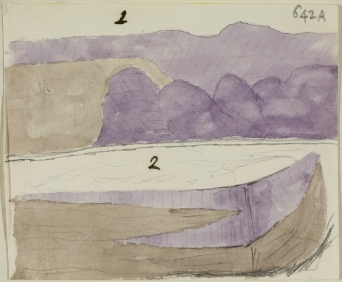
2
[This is the only known coloured sketch in the Beagle field notebooks.]
[page 30b]
[excised: located in CUL-DAR37.642Av]
Strata at varying dips. — I can only look at this spot as a Volcano: — (NB the junction of valleys seen often to occur in midst of Crystalline Hills) Also another Bluff point (1) where the appearance does not seem that of injected rock — but rather of the stream of very red Porph— which have had sedimentary strata deposited between a part of: therefore the bluff part must before upheaval have been near the Volcano —
P. 158 Copiapò
[page 31b]
A section of about 7000 ft of Lower of P B formation gave. — 1st or lowest P Brecc Conglom & Breccia smaller particles blended — larger yet distinct, basis partially crystalline several 100 ft thick — 2
Purple porphyry 60 ft quite distinct (184) 3 Porph Brecc great thickness 3 4 Greenish Porph (185) 80 ft (5) slightly crimson, position with the mechanical rock quite evident. (5). Porph Brecc or conglomerate 30 ft
(6) The same Porph (185) about 30 ft — I believe covered again by the dull blackish slightly purplish Conglom
[page 32b]
= I returned to Valley of Copiapo — smell delicious of the clover fields after the desert journey: At P Gorda at least 8 7-9 miles from the nearest water & that in very small quantity, & Indians had no animals — land quite desert — every two or three years there is a little rain pasture enough for a few weeks (but not enough for Horticulture) = Not a concealed place, now where there are these tiny [Pozos] are very much concealed — cannot be said to have run away — At this P Gorda 6 or seven little apartments partly constructed of mud
[page 33b]
(& this mud surpasses in hardness present mud [mem]) chiefly stones — figure & some like the huts, in pass of Aconcagua: — Also in front of side ravine, in several places two piles of stones, apparently as a mark = I hear of great numbers of houses in all parts of Cordilleras & not only in the Passes: some between the ranges where there is Puna, desert excepting for a very short time in summer & snow all winter — many of these groups of
[page 34b]
at immense elevation where there is no water — Where at present silver mines could hardly be worked, & that with advantage of having animals — are considered as places of residence Indian corn, bits of woollen threads, Guanaco & I have head of arrow of Agate precisely like T del Fuego. I hear of these groups of houses in all parts — Valley of Aconcagua [&c] [Maupas] &c — muchissimo Only one idea to feed Alpacas — but failing water — I cannot understand — & excessive cold —
[page 35b]
Has there been a change of climate. I believe stone walls remain for ever: Mem. Druidical mounds —
Houses top of Cerro Bravo — People say they are animals — not being Christians explains any thing: —
Thursday 2 - Friday 3d [July 1835] Staid in Copiapò Mine of Silver — Gold — Copper — in the Syenite near town — magnetic iron. in the district — Quicksilver also & Lead =
[page 36b]
Saturday 4th [July 1835] Set out for Port Valley soon expands large patches friable white as snow, miserable sort of sterile grass not fit & brownish green — some large Algarroba — Rocks, which I examined granite — G. syenite — Greenstone & slate — coloured porph remarkable by the great number of dykes chiefly N & S — & from hardness forming the [sub] ridge — so that every
[page 37b]
part of valley has been highly disturbed & is metaliferous — Valley more level & soft earth — difference with other Chilean valleys —
cause & effect — on side below the Ramadilla — two plains on the side, the upper one being hard crystalline rock smoothed down & interstices filled up by numerous pebbles — Perhaps the broad plain
[page 38b]
of valley is alluvial, at some former period, or from some cause too horizontal for transportal of gravel — the side plains as before, with gravel. — Salitra — analysis by Apothecary Hull1 — Thick [crumbling] mass in the lower patches of valley & more or less all over it — water tasted by it = Mountains remarkable by being covered with sand — like Dunes even
1 Possibly James G. Hull, resident of Santiago, Chile.
[page 39b]
these from 1000 ft to 2000 ft high
Sunday 5th [July 1835] — Saw some Clay Slate or rather siliceous Feldspathic slate & Hornblendic Slate (2848-49) & again near coast true Granite = small bits of plains with sandy earth hence perhaps valley is not alluvial = On the plain certainly higher than at Guasco, the recent Donax, & Venus ( ) & Pecten, in cemented grains, of sand & shells, like Losa, or a
[page 40b]
brownish Tosca rock — Beneath this various coloured yellow or greenish sand — seams of Gypsum — many large pebbles of Granite & Large Oysters = formation very same as Coquimbo
Monday 6th [July 1835] Examined cliffs near the Port = chiefly a [hardish] yellow mass of comminuted shells I believe of the recent period = there were layers of soft white & even reddish sandstone, & thinly lam
[page 41b]
inated stratified Tripoli (2847) in this very great number, chiefly horizontal veins of Gypsum = some large bones = The upper part gravel also more decidedly of the recent period with very many Venus (2846). Pecten Oliva Barnacles & other species Venus (& whole Barnacle) — In this fine sediment enormous blocks of granite 2 yards long 1 — wide 4 ft high. From the ship a little way to
[page 42b]
north the Strata appeared inclined as if tilted — (Resting the Strata on the worn surface of the granite — [234]
Iquique 20º 13 - S
Sailed from Copiapo 6th [July 1835] — reached Iquique 12th
Sailed 15th [July 1835]
[page 43b]
13th
Sea 30.382
Beach —
T 64.—
First 28.450
T 65 —Plain — T 44
Salt 27.026 T 63
Petre 22
Iquique 30.360 Pintado1 at Iquique Sailed from Lima 7th of September [1835]
1 The Cape Petrel, which Darwin later noted 'often approached close to the stern of the Beagle…the constant attendants on vessels traversing these southern seas.' listed as Daption capense in Birds, p. 140.
[page 44b]
I hear of the Crater of extinct Volcano — Hot water — Sulphur — Smoke — near Iquique & two in Atacama. —
Absence of Volcanos in Copiapo & Guasco account for frequent Earthquakes
Probable steps same height in diff valleys
[page 45b]
19th [July 1835] at night outside of Callao = short — [cloudy] passage —
20th [July 1835] Swept in — miserable Callao, Soldiers — green country
21st [July 1835] Isd of St Lorenzo — not so desert in the region [cloud] — much [Amancaes]1 — several other plants —
cold. Drizzle = Callao — flat roofs — Heap of corn — fruits — splendid Castle not only low down —
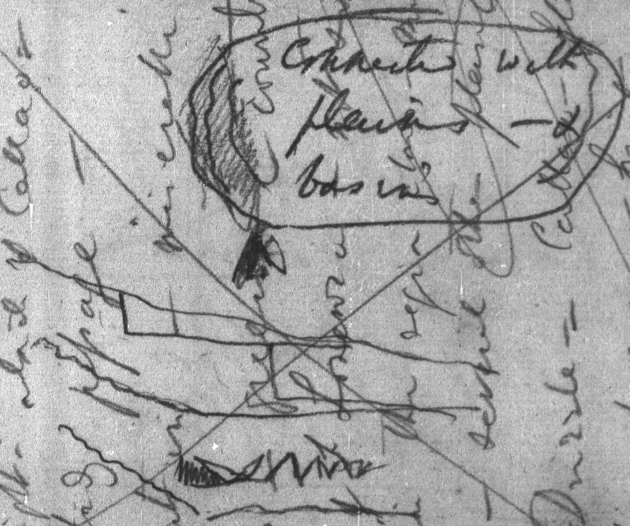 |
Connected with plains — & basins
Valleys marine — Alluvium
Rise gradual
periods of long repose or greater upheaval
|
1 'beautiful yellow lilies', Beagle diary, p. 348; see Beagle plants, p. 181.
[page 46b]
Remarkable coincidence in overthrow of Juan Fernandez & Concepcion in the year 35 + 51 — each time great wave. parallel case to wave on coast of Lisbon & Madeira.
Playfair discussion on valleys — compare Sand Hills [Oyster]
English Harbor.
Salt in Guasco or at Copiapo — Extent of Tosca
[page 47b]
6 7 Coral, few grains of broken sh[ell]
Sand chiefly, with some Coral, many soundings
12 Fathom Lamelliform
C. Madrepore1 seriatopora no doubt living upright 15 F. dead Seriatopora & a [mark] of Lamelliform
1 Reef-building hydrocorals. See Zoology notes, p. xiii and p. 310 note, and description of specimen 3560, p. 307.
[page 48b]
20 ½ Fathom — Madrepore of the stony kind — mark of Lamelliform
When the coral luxuriant arming quite clean
14 Fathom fine grained astrea1 or  [corals]
[corals]
15 splendid astrea 5 dead & frequently dead
1 'Astrea' (Darwin's spelling in Coral reefs is 'Astraea') has no directly equivalent modern generic name, although it is probably the stony coral Acanthastrea. Zoology notes, p. 419 identifies Darwin's specimen not in spirits 3608 as 'possibly a Favia' i.e. a brain coral.
[page 49b]
Seriatopora
27 all sand
30 coarse do
20 living Seriatopora1
18 do.
20 do.
30 coral probably living
xx a [immense] Caryophillia
1 This may correspond to specimen not in spirits 3633 'Seriatopora, in 20 Fathom water', Zoology notes, p. 419, collected at Mauritius.
[page 50b]
33 F fine sand
24 F do
20 Seriatopora
18 do & mark of some (III)? Stony coral
18 Seriatopora
11 fathom Lamelliform on [sound] to ship & therefore nearer harbour mouth
[page 51b]
Lead nearly 4 inches in diameter. I struck the ground many times which if sand would not effect the lead, but would if Coral. |Diameter of Lead nearly 4 inches.
30 xx) A large patch arming indented & fluted: clean:
Apparent [in] tank, [sandy]
[page 52b]
Madagascar — African coast ships deep [there] 20-30 fathoms delay — mon monoceros
Tuesday 31st [May 1836] arrived in evening Simons Town, 2 or 300 white houses scattered along beach backed by very barren wall of rocks — |
Wednesday morning [1 June 1836] after noon took Gig for Cape Town pleasant drive, succulent plants, heaths, rather nice about Wijnberg oaks, scotch firs, shady leaves white houses as [from] a town dropped in country but always close to road
[page 53b]
nice houses — country naturally very barren great flat with solitary houses as on the Pampas, separating mountains from island mountains — arrived after dark 2
Thursday [June 1836] wandered & rode about town — lodging houses — churches streets with trees square. parade backed by [really] very splendid wall of the well known table
[page 54b]
mountain — waggon most extraordinary feature 18 bullocks like a field of cattle all caught, 6 & 8 in [hand] horses & mules — quite English town. about 15000 in town Lions hill, Slate [compact] blue. semicrystalline (calcareous?) covered irregularly by pale not hard sandstone, in parts laminated & micaceous
[page 55b]
veins of quartz not very compact — dendritic manganese — a kind of cleavage (NW ??) common to underlying Slate & Sandstone?
Tertiary ferruginous earthy sandstones, unequal structure like K G Sound —
4 Saturday [June 1836] started on a short ride of four days; first to the Praal; sandy flat &
[page 56b]
hills with thin pasture, many small flowers Oxalis like M: Video = solitary white houses like in Pampas more tidy — Evening arrived at sort of boarding house. — ascended splendid round granite hills behind village, row of all tidy white houses & gardens, avenues of small oaks & many vineyards. — general color brownish green no trees pretty well watered — Table mountain very
[page 57b]
level over flat — Western mountains reddish & grey, not fine forms, 3-4000 ft. — Extraordinary fissures & boulders of Granite, caverns beneath — On road, very quartzose white sandstones & some do breccias = A concretionary ferruginous stone very common with cavities, & yellowish. sandy clay — Mem coincidence of ferruginous stone & casts of trees here & K G Sound
[page 58b]
Sunday 5 [June 1836] Across pass of French Hoeck, considerable work, grumble at toll bar. the Dutch hospitable but not like the English. Emancipation not popular to any people, yet will answer — valley something like Wales on E side of pass wild valley white quartz green grass no trees — solitary — Comfortable Mr Holms house Toll
[page 59b]
Bar — 1º oclock —
East of pass all mountains ranges short declining towards S End. with faults all dipping to SSE or SE compass 20º-30º degrees — but on pass, there is a spur sent
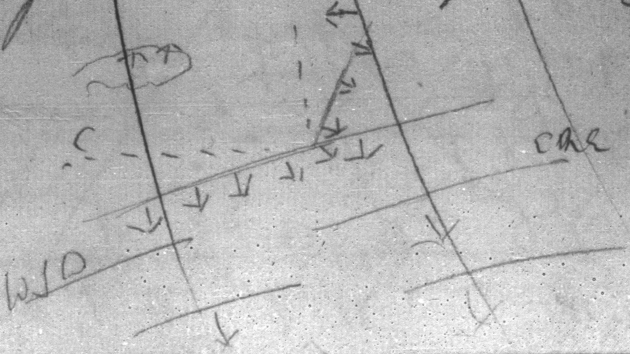 [map]
[map]
[page 60b]
off to the North, with dip to E & W this dip bends in a circle at summit of pass till it joins the E & W ranges — very remarkable stratification — intersection of two lines — In the E & W lines strata dipping towards range 60º summit arched & flattened

[sketch of hill] other part
[page 61b]
curvilinear — lower part of sandstones, [siliceous] slightly ferruginous, sometimes very much so, sometimes white & laminated —
[sketch of strata]
patches of white quartz veins
Above this about 80 ft thick of softer ferruginous
containing [numerous] angular & semirounded small |

|
pebbles of white quartz & again above rather more compact
[page 62b]
[cliff section]
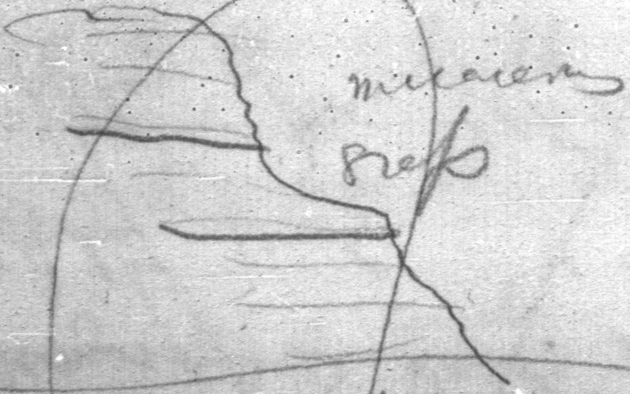
micaceous gneiss
Remarkable Table Mountain
horizontal stratification
Monday 6 [June 1836] I saw the E & W ranges South of Caledon, the mountains in the curved road to the Palmiet River is a
& Zonder end do
[page 63b]
perfect chaos = country very desolate solitary mountainous, few animals, farm houses in valleys — no trees, wild deer large white vultures like Condors — Band of mountains. When we arrived in evening at Mr Gadney's1 found party of five men Boer — runaway rascals spirited fellows —
1 William Gadney, a British merchant resident in Cape Town who turned his Sea Point home into a lodging-house after a business failure.
[page 64b]
long guns. leathern breeches, poor horses = grey, rocky tame mountains, most monotonous ride
7th [June 1836]
Sir Lowry Coles Pass, fine cut, hot wind, gale from N
Sand dunes, mountainous Sandstone resting on fine grained granite, strata inclined
[page 65b]
X Clay Slates weathering into sandstone.
Clay Slates Lions Rump dipping pretty regularly to E by N compass at about 45º. — approaching Granite (same which underlies Lions Head) becomes compact & [homogenous] — then in parts
[page 66b]
white spots appear Feldspathic which the weathering makes rock cellular, then granular & black micaceous fine grained mica in spots — slate laminated same direction mean line of junction parellel, running cross country pale siliceous granite (by [chance]) near junction dykes of do
[page 67b]
Junction very [extraord] some hundred yards granite appears veins with [this] kind of mica Slate, streaks appear dissolved [long] gradually increasing with here & there patch of large grained (as commonly) granite — Many dykes in granite. E & W? [country]
[page 68b]
horizontal fault, some dykes at ┴º — (no true Boulders)
Dr Smyth1 — Karroo Clay Slate
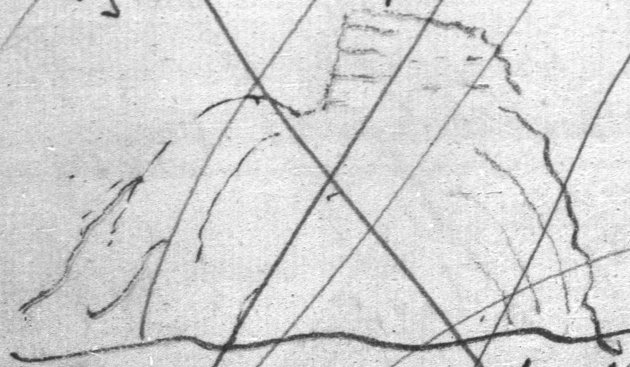 [Karroo hill? South Africa]
[Karroo hill? South Africa]
Granite remarkable from weathering. hollow. cavities
Near Green Point patch of sand. coated with Tosca rock
1 Andrew Smith (1797-1872), army surgeon, naturalist and explorer. Served in South Africa, 1821-37. Mentioned in the Geological diary CUL-DAR 38.902-919, the Beagle diary, p. 427/740 and the Red notebook, p. 38. He is sometimes described as the father of zoology in South Africa
[page 69b]
impressions of trees, carts like K.G Sound. On plains of [true] Tosca rock V Specimen On [old] Isthmus new Ferruginous sandstone Smith Junction of clay Slates & white [siliceous] Granite N B. many quartz veins in granite near junction
[page 70b]
(Z1) nearest
(Z2) a little further
(Z3) considerably further
(Z4) some hundred yards distan[ce] Slate not altered
White siliceous granite within junction near to Clay Slate
Walked to Lions Head
[page 71b]
& so to Rump — The Slate is affected to the distance of ¼ of mile, micaceous & compact & granular or dotted, — quite [gneiss] close to number (Z X) direction invariable, dip to opposite point or vertical, white granite veins — a
[page 72b]
A not very hard, slightly siliceous ferruginous sandstone immediately on granite, & red shale —
Sandstone 12000 ft —
Story of the [Cuentas]
8 Wednesday [June 1836] Coast to ship
9 Thursday [June 1836] not very well
10 Friday [June 1836] long walk
[page 73b]
Sunday [12 June 1836] Museum long walk
13 Monday [June 1836] evening Colonel Bell1
15 [June 1836] — Sir J Herschel2
16 [June 1836] Returned to ship
17 [June 1836] Walk with Sulivan3
18 [June 1836] Sailed. — windy Mem at C of Hope SE bearing corrected wrongly
1 John Bell (1782-1876), army officer.
2 John Frederick William Herschel (1792-1871), astronomer, mathematician, chemist and philosopher of science.
3 Bartholemew James Sulivan (1810-1890), second Lieutenant on the Beagle.
[page 74b]
29th [June 1836] Crossed Tropic: Light northerly winds arrived on Friday 8th [July 1836] in morning: rock wall round Isd — Volcanic ∴ harbourless, thinly stratified — Fortresses mingled with rocks — small town. little flat valley, — not magnificent forts — Walked up ladder hill — curious = Walked to High Knoll castle or Telegraph: very picturesque at a distance. like old Welsh castle. = Wonderful contrast decomposed humid rocks, green vegetation. from
[page 75b]
mem rocks of coast; fine scenery, fir grows pretty because not confined — every patch of ground cultivated little white houses placed in most marvellous position deep valleys or naked pinnacles = All talk English — very poor the poor appear —
Saturday. [9 July 1836] Obtained Lodgings in country in centre of Isd near stones throw of Nap[oleon']s grave — no romance cottage & road close by & bombast & nonsense, sublime &
[page 76b]
ridiculous = Mist & wretched cold nice Cottage =
Sunday [10 July 1836]
Things improved. — hired guide 55 years old — feet like iron — mulatto.
So many times crossed, that has not disagreeable look — quiet very civil old man, was slave, has 40£ to pay for freedom. How is this?
Walked to Flagstaff along same course, elevated plain — Passed long wood, cultivated fields — rather but no very bleak — gentlemans houses — hovel where he really lived & died very poor — I took shelter during heavy rain,
[page 77b]
shutter rattling about Walls scored with names of Seamen & Merchant captains. It appeared degradation, like profaning old castle — Green plain short thin grass — few Syngenesia trees = great red & white Hills called Flagstaff & great Black barn: Lime Uninteresting view: every Govt. path blockaded — such wild little spots, old picket houses. — Wild arid villages — Even near sea Cactus & 2 or 3 plants in very small quantities
[page 78b]
Monday [11 July 1836] Walked Bencoulen Plain down to Prosperous Bay — passed Guard House & fort — 2 soldiers, 2 invalids at old Telegraph House, where army cause appears to me absurd & in Wonderfully protected & guarded. —
Returned across very pretty valley, fir woods — yellow flowering gorge, willow trees & little brook — cottages & small white houses & green rocky hills —
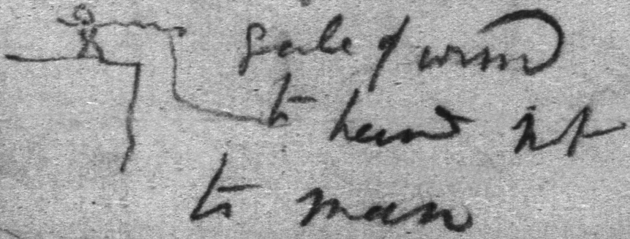 gale of wind to hand not to man
gale of wind to hand not to man
[figure of a man, possibly Darwin, probably on the cliffs overlooking Prosperous Bay, St Helena]
Mem Tern 120 to sea. — in flock.
[page 79b]
Wednesday [13 July 1836]
Lott & Lotts wife. I believe parts of same ENE dike: = Lott Lower part laminated [curvilinear] globular — angular — [columno] — radiated has effected strata on both sides not quite ∆ base rather broader 2-300 ft high = linear train of volcanos = dike of nearly ┴º to this & great isolated peaks. I believe even Man of Wars Birds Roost — [if] [this constitution]. — Greenstone pale a green [compact] was reminded of peaks in
[page 80b]
Greenstone countries = Sandy valley chaos of reds yellows [& hollow consist] chiefly of decayed red scoriae, yellow [wacke] full of [augite] crystals cellular lavas & other decomposed kinds many dikes lower parts amygdaloid = great amphitheatre incompletely to S.W. compass = Barn black strata end above, the colored strata dipping to SE by E (Comp) & in front by sandy [bay] beach, obscure
[page 81b]
seaward dip — to West nothing to be seen = Wall of modern Crater — chiefly decomposed red scoriae & as before mentioned with lower ledge & dipping outwards mem wall — [certainly] Crater. further west than High peak which [in part] —
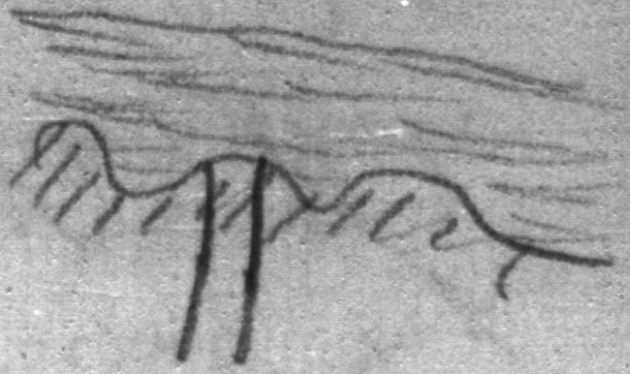 [dyke on St Helena]1
[dyke on St Helena]1
In part on [outside] [Hence] probably terrestrial —
Looking round Isd colored beds
1 See the fair copy in the geological diary DAR 38.931v; a later version of this sketch appeared in Volcanic islands, p. 82.
[page 82b]
in very small proportion on West side; beneath Horse pasture, black bed. quaqua-versal dip, whole way to High Knoll Hill, & even to extreme WSW (comp) end of Island — Crater both ancient (if such existed) & modern quite vanished to SSW & S (true) —
High Hill appears mass of greenstone. — great cone —
[page 83b]
also perhaps mass beneath Man & Horse — (N.B. name is Long Range & Not Mountain) & other knolls as in Crater —
 Leeward
Leeward
Tern 120 miles
action of sea — greatest where high tidal. mem effect on prolonged elevation modern conglomerate —
Calcareous sand (in parts agglutinated into hard sand from having [vein] — in patch 12tion must have contained some calcareous matter. —Blasted because so soft !!
[page 84b]
400 ft (& at Lotts wife) following form of hill then strata highly inclined, fragments gullies from such collection coast stones.
stalactiform specimen; Hence stone in [last] place — no white sand in Isld now Sea at that elevation must have contained some calcareous matter. — Blasted because so soft !!
[page 85b]
ENE & WSW Longer axis?
Lotts wife  [Lot's Wife?] like at Galapagos — modern conglomerates Sailed 14th [July 1836] ≠ Soda plant1 Game laws ≠ English vegetation shading into rocks instead of leafless woods —
[Lot's Wife?] like at Galapagos — modern conglomerates Sailed 14th [July 1836] ≠ Soda plant1 Game laws ≠ English vegetation shading into rocks instead of leafless woods —
Sir W. Doveton2 — [bread], — Fruit, number of plants, Tobacco — [found] on top of High Rock proportionate numbers
1 'Partridges & pheasant are tolerably abundant; the Isd is far too English not to be subject to strict game laws. I was told of a more unjust sacrifice to such ordinances, than I ever heard of even in England: the poor people formerly used to burn a plant which grows on the coast rocks, & export soda; — a peremptory order came out to prohibit this practice, giving as a reason, that the Partridges would have no where to build!' Beagle diary, pp. 429-30.
2 William Doveton (1753-1843), magistrate and judge. Napoleon famously died after a picnic at Doveton's house in 1820.
[page 86b]
Sand at Galapagos —
Structure of shell sand, sometimes no trace of shells
Effect of lower mass being so stretched with dikes?? when some of the dike 3 & 400 ft  [perhaps the crater between Flagstaff Hill and the Barn, St. Helena, showing stretching due to multiple injections]1
[perhaps the crater between Flagstaff Hill and the Barn, St. Helena, showing stretching due to multiple injections]1
Anomalous action of sea Southern rocks all buoyed with Kelp yet the Il Defenso rocks like those in the [Hebrides] bear most clear token of degradation: Water so muddy Callao beach [ratling] perfect mill. —
1 See the sketch in the geological diary DAR 38.929 and Volcanic islands, p. 76 fig. 8.
[page 87b]
Arrived Friday [12 August 1836] — bad passage, heavy rains, winds Easterly — Pernambuco low green, land, rising a little toward old Olinda Pilot ran in very curious breakwater — Light-house Walked through town, filthy narrow streets, tall houses, prisons — built on mere sand banks [gained from] sea — Connected by broad
[page 88b]
wooden bridge — population of black & brown. flithy old Hags of Nuns — White men appear as foreigners — A good many horses wild. young Portuguese — Structure of reef, width length Lyell Vol. I P. 314 Refers to Hoff about T del Fuego & Patagonia1
1 Lyell 1830-3, 1: 314: 'Of these great regions, that of the Andes is one of the best defined. Respecting its southern extremity, we are still in need of more accurate information, some conceiving it to extend into Terra del Fuego and Patagonia.' Lyell referred to Hoff 1822-4, 2: 476.
[page 89b]
Granitic sand. coarse composed of [rounded] pebbles of quartz distinct horizontal strata — [analog] with Bahia, sand spotted with red & yellow clayey matter — layers & lumps of greasy lithomarge upper parts, red alluvium — Water worn
Water worn
[page 90b]
highest land in country part of plain — round great big yellow limestone becoming arenaceous & aluminous yellow clay No shells — But conglomerate & sandstone with shells in quantity, [from] neighbourhood recent elevation possible
[page 91b]
Mangroves like rank grass in Church Yard —
Swamps [unhealthy]
Olinda Old Town
Ill-natured Brazilians
Did the metamorphosed gneiss at Bahia contain dike before metamorphic action?
Textual notes to the Despoblado notebook
[IFC] 1.6] Down House number, not transcribed.
88202326] English Heritage number, not transcribed.
[1a] page written perpendicular to the spine.
[5a-10a] pages partly excised.
[11a] page written perpendicular to the spine.
[IBC] written perpendicular to the spine.
12] added by Nora Barlow, pencil, not transcribed.
[2b-42b] pages written perpendicular to the spine.
[24b] 'Mon' (apparently a nib test) and sketch in ink.
[25b] ten scribbles like 'MM' written in ink and strong scratching, suggesting that Darwin used the page to test his pen.
[27b] there is pink and mauve watercolour paint on this page matching the colours on 29b.
[29b] sketch is painted with watercolour.
[29b-30b] leaf excised, now in DAR 37.642A.
[30b] P. 158 Copiapò] blackish ink written over other entries.
[31b] cut near the spine as a result of the excision of 29b-30b by a sharp knife.
[43b] Sailed...September] added pencil.
[44b] page written perpendicular to the spine.
[45b] not only...period] in ink written perpendicular to the spine.
[46b] page written perpendicular to spine.
[51b] |Diameter...inches] added pencil.
[52b] mon monoceros] added ink.
[67b] Many...[country]] added heavy pencil.
[68b] added heavy pencil.
[The Beagle field notebook identifiers were re-set in January 2021 meaning the page counters were reset to 0. At that time this notebook had 10022 visits.]
 REVISION HISTORY: Scanned by Historic England. Transcribed by Gordon Chancellor, transcription typed and checked against the microfilm by Kees Rookmaaker, corrected by Chancellor 4.2007. Edited by John van Wyhe 5.2007, partially checked against the manuscript by Chancellor 10.2007. Corrections and editing agains the microfilm by van Wyhe 8.2008. Transcription revised and edited by van Wyhe 10-12.2008, 2024. RN16
REVISION HISTORY: Scanned by Historic England. Transcribed by Gordon Chancellor, transcription typed and checked against the microfilm by Kees Rookmaaker, corrected by Chancellor 4.2007. Edited by John van Wyhe 5.2007, partially checked against the manuscript by Chancellor 10.2007. Corrections and editing agains the microfilm by van Wyhe 8.2008. Transcription revised and edited by van Wyhe 10-12.2008, 2024. RN16










 [corals]
[corals]  [map]
[map]


 [Karroo hill? South Africa]
[Karroo hill? South Africa]  gale of wind to hand not to man
gale of wind to hand not to man [dyke on St Helena]1
[dyke on St Helena]1  Leeward
Leeward  [Lot's Wife?] like at Galapagos — modern conglomerates Sailed 14th [July 1836] ≠ Soda plant1 Game laws ≠ English vegetation shading into rocks instead of leafless woods —
[Lot's Wife?] like at Galapagos — modern conglomerates Sailed 14th [July 1836] ≠ Soda plant1 Game laws ≠ English vegetation shading into rocks instead of leafless woods — [perhaps the crater between Flagstaff Hill and the Barn, St. Helena, showing stretching due to multiple injections]1
[perhaps the crater between Flagstaff Hill and the Barn, St. Helena, showing stretching due to multiple injections]1  Water worn
Water worn